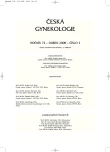Levels of Prostaglandin E2 (PGE2) in Cervical Ovulatory Mucus in Women with Spontaneous Miscarriages
Authors:
M. Ryantová 1; Z. Ulčová-Gallová 1; Z. Mičanová 1; K. Bibková 1; B. Šedivá 2
Authors‘ workplace:
Gynekologicko-porodnická klinika LF UK a FN, Plzeň, přednosta doc. MUDr. Z. Rokyta, CSc.
1; Katedra matematiky, Fakulta aplikovaných věd, Západočeská Univerzita, Plzeň, vedoucí prof. RNDr. P. Drábek, DrSc.
2
Published in:
Ceska Gynekol 2008; 73(2): 98-101
Overview
Objective:
The aim of this study was to compare levels of PGE2 in cervical ovulatory mucus in patients with various frequency of spontaneous miscarriages, and in healthy fertile women.
Setting:
Special Consultation for Immunology of Reproduction and Research Laboratories for Reproductive Immunology, Department of Gynaecology and Obstetrics, Medical Faculty of Charles University and Faculty Hospital, Pilsen.
Methods:
We used commercial, high sensitive method of ELISA (PGE2 HS, R&D Systems) for detection of PGE2 in cervical ovulatory mucus. Statistic analysis (T-test, ANOVA-test and Kruskal-Wallis test) also provided our study.
Results:
It was taken in total 120 measurements.The R&D Systems company does not mention physiological levels of PGE2 in cervical ovulatory mucus. Therefore we compared all results of our studied groups with average concentration (197.356 pg/ml PGE2) gained from control group.We found that in patients with one miscarriage PGE2 levels are approximately 6 times higher, with two miscarriages 13 times higher, and in patients with three and more miscarriages even 21 times higher than controls (p<0.0327, α 5%).
Conclusion:
In present literature does not exist any study concerning of PGE2 in cervical ovulatory mucus. We prove that some patients mainly with repeated „unexplained“ miscarriages have ovulatory levels of PGE2 significantly higher than controls.
Key words:
prostaglandin E2, cervical ovulatory mucus, miscarriage
Sources
1. Arosh, JA., Banu, SK., Chapdelaine P., et al. Prostaglandin biosynthesis,transport, and signaling in corpus luteum: a basis for autoregulation of luteal function. Endocrinology, 2004, 145, 5, p. 2551–2560.
2. Arosh, JA, Banu, SK, Chapdelaine, P.,et al. Molecular cloning and characterization of bovine prostaglandin E2 receptors EP2 and EP4: expression and regulation in endometrium and myometrium during the estrous cycle and early pregnancy. Endocrinology, 2003, 144, p. 3076–3091.
3. Arosh, JA., Parent, J., Chapdelaine, P., et al. Expression of cyclooxygenases 1 and 2 and prostaglandin E synthase in bovine endometrial tissue during the estrous cycle. Biol Reprod, 2002, 67, p. 161–169.
4. Astle, S., Thornton, S., Slater, DM. Identification and localization of prostaglandin E2 receptors in upper and lower segment human myometrium during pregnancy. Mol Human Reprod, 2005 11, 4, p. 279–287.
5. Cheng, JG., Stewart, CL. Loss of cyclooxygenase-2 retards decidual growth but does not inhibit embryo implantation or development to term. Biol Reprod, 2003, 68, p. 401–404.
6. Čech, E., Hájek, Z., Maršál, K., a kol. Porodnictví. Praha: Grada, 2006, 188 s.
7. Goff, AK. Steroid hormone modulation of prostaglandin secretion in the ruminant endometrium during the estrous cycle. Biol Reprod, 2004, 71, p. 11–6.
8. Helliwell, RJ., Adams, LF., Mitchell, MD. Prostaglandin synthases:recent developments and a novel hypothesis. Prostaglandins Leukot Essent Fatty Acids, 2004 , 70, 2, p. 101–113.
9. Jaschevatzky, OE., Shalit, A., Grunstein, S., et al Increased decidual prostaglandin E concentration in human abortion. Br J Obstet Gynaecol, 1983, 90, 10, p. 958–960.
10. Kudo, I., Murakami, M. Prostaglandin E synthase, a terminal enzyme for prostaglandin E2 biosynthesis. J Biochem Mol Biol, 2005, 38, 6, p. 633–638.
11. Lim, H., Paria, BC., Das, SK., et al. Multiple female reproductive failures in cyclooxygenase 2-deficient mice. Cell, 1997, 91, p. 197–208.
12. Majerus, PW. Prostaglandins – critical roles in pregnancy and colon cancer. Curr Biol, 1998, 8, R87–R89.
13. Milne, SA., Perchick, GB., Boody, SC., Jabbour, HN. Expression, localization, and signaling of PGE2 and EP2/EP4 receptors in human nonpregnant endometrium across the menstrual cycle. J Clin Endocrinol Metab, 2001, 86, p. 4453–4459.
14. Morozova, MS., Goncharova, VN., Astakhova, TM., et al. Prostaglandin content in decidual tissue of women in spontaneous abortion. Akush Ginekol(Mosk),1994, p. 14–16.
15. Narumiya, S., Sugimoto, Y., Ushikubi, F. Prostanoid receptors: structures, properties, and functions. Physiol Rev, 1999, 79, p. 1193–1226.
16. Narumiya, S., Fitzgerald, GA. Genetic and pharmacological analysis of prostanoid receptor function. J Clin Invest, 2001,108, p. 25–30.
17. Sales, KJ., Jabbour, HN. Cyclooxygenase enzymes and prostaglandins in reproductive tract physiology and pathology. Prostaglandins Other Lipid Mediat, 2003, 71, 3-4, p. 97–117.
18. Sun, T., Li, SJ., Diao, HL., et al. Cyclooxygenases and prostaglandin E synthases in the endometrium of the rhesus monkey during the menstrual cycle. Reproduction, 2004, 127, 4, p. 465–473.
19. Tilley, SL., Audoly, LP., Hicks, EH., et al. Reproductive failure and reduced blood pressure in mice lacking the EP2 prostaglandin E2 receptor. J Clin Invest,1999, 103, p. 1539–1545.
Labels
Paediatric gynaecology Gynaecology and obstetrics Reproduction medicineArticle was published in
Czech Gynaecology

2008 Issue 2
Most read in this issue
- Abortion Induction in IInd trimester
- Persistent Trophoblastic Disease in Trophoblastic Disease Center in the Czech Republic in 1955 – 2007
- The Importace of Sonography and Hysteroscopy at Suspected Findings on Endometrium of Menopausal Women
- Adrenocortical Disorders in Pregnancy
